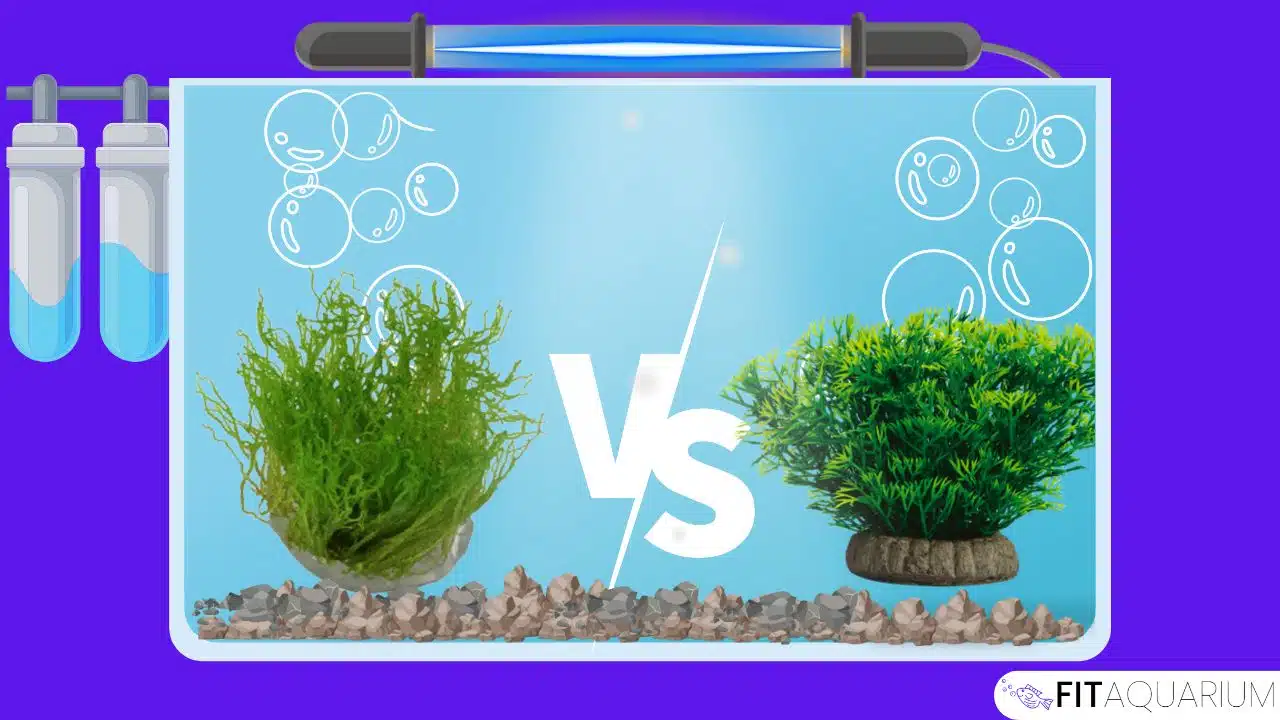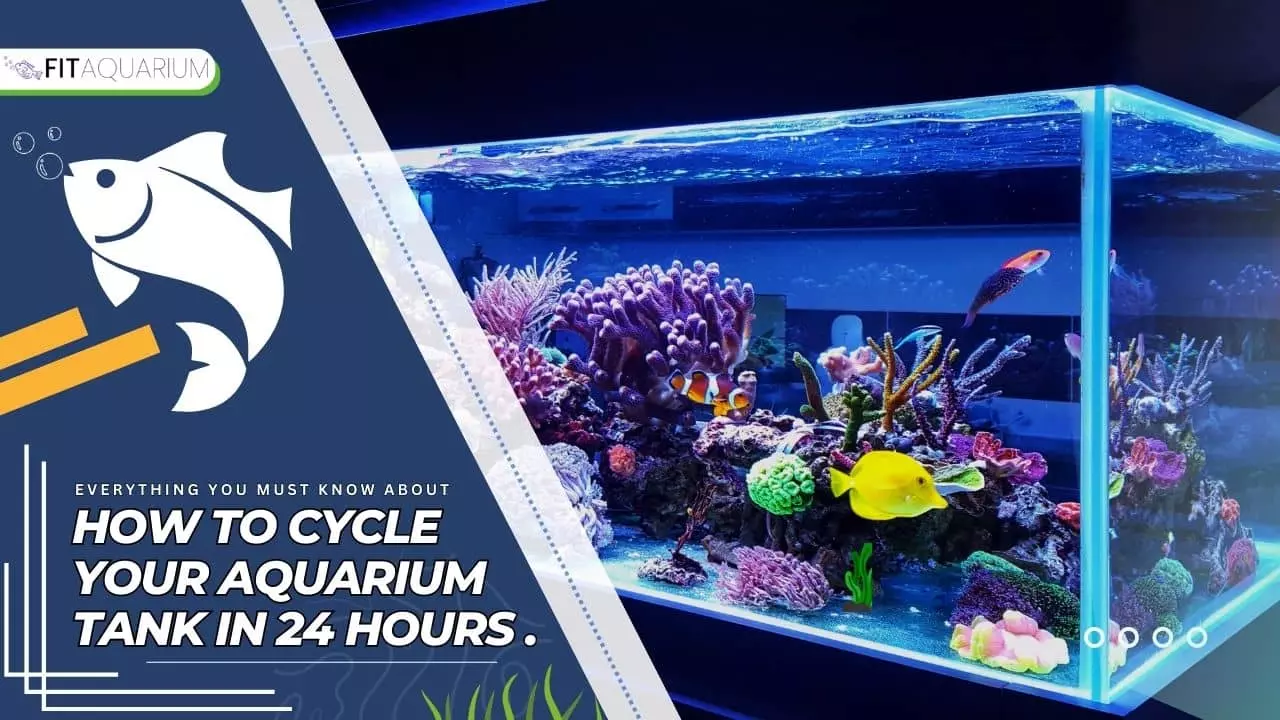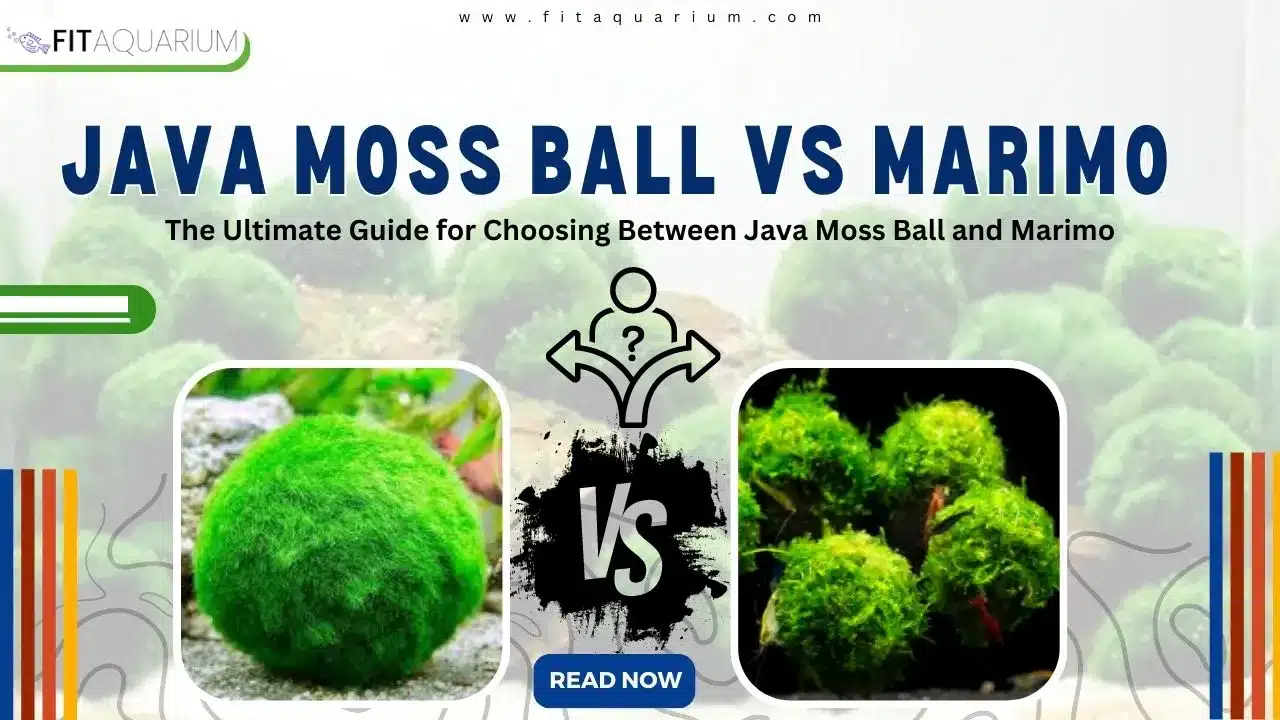The Koran Angelfish, scientifically known as Pomacanthus Semicirculatus, is a beautiful and distinctive marine fish that requires special care to thrive and can make a great addition to saltwater aquariums. In this care guide, I will provide you with all the information you need to ensure the health and happiness of your Koran Angelfish.
Point to Remember: The name is “KORAN ANGELFISH” not “KOREAN ANGELFISH”.
Table of Contents
Koran Angelfish Profile
The Koran Angelfish is a large and vibrant fish known for its unique color patterns. As juveniles, they display a black body with striking blue and white semicircular stripes, resembling the curvature of the typography found in the Arabic scripts.
Fact: The Koran angelfish is so named because once at a time a juvenile with abnormal striping was discovered with markings resembling the Arabic writing for ‘Quran’, the Holy book of Islam.
However, as they mature, their appearance undergoes a dramatic transformation. The lime-colored body of the adult Koran Angelfish gradually fades into black towards the caudal fin, with an electric-blue trim outlining the entire fish.
These angelfish are native to the Indo-Pacific region and are typically found in pairs or solitary, swimming near heavy coral cover. They primarily feed on algae and tunicates, which are abundant in their natural habitat.
Koran Angelfish Care Sheet:
| Scientific Name | Pomacanthus Semicirculatus |
|---|---|
| Common Names: | Koran Angelfish, Semicircle Angelfish, Koran Angel, Blue Angelfish, Saltwater Koran Angelfish |
| Family | Pomacanthus |
| Origin | Africa, Caribbean, Maldives, Indonesia, Sri Lanka |
| Size | 14 inches (37 cm) |
| Temperament | Semi-aggressive |
| Mode of Nutrition | Omnivore |
| Suitable Water Temperature | 72°F – 80°F (22°C – 27°C) |
| Alkalinity | dKH 8 – 12° |
| Specific Gravity | SG 1.020 – 1.025 |
| Suitable pH | pH 8.1 – 8.4 |
| Reef Compatibility | With Caution |
| Minimum Tank Size Required | 125 Gallons (for single specie) | 180 Gallons (for community tank) |
| Care Level Required | Moderate |
| Water Preference | Saltwater |
Size and Appearance
The baby fish’s body is bluish-black and decorated with concentric semicircles. The Blue Angelfish changes colors on being an adult. The Koran angelfish changing color will typically occur over the size range of 8-16 cm / 3-6 in.
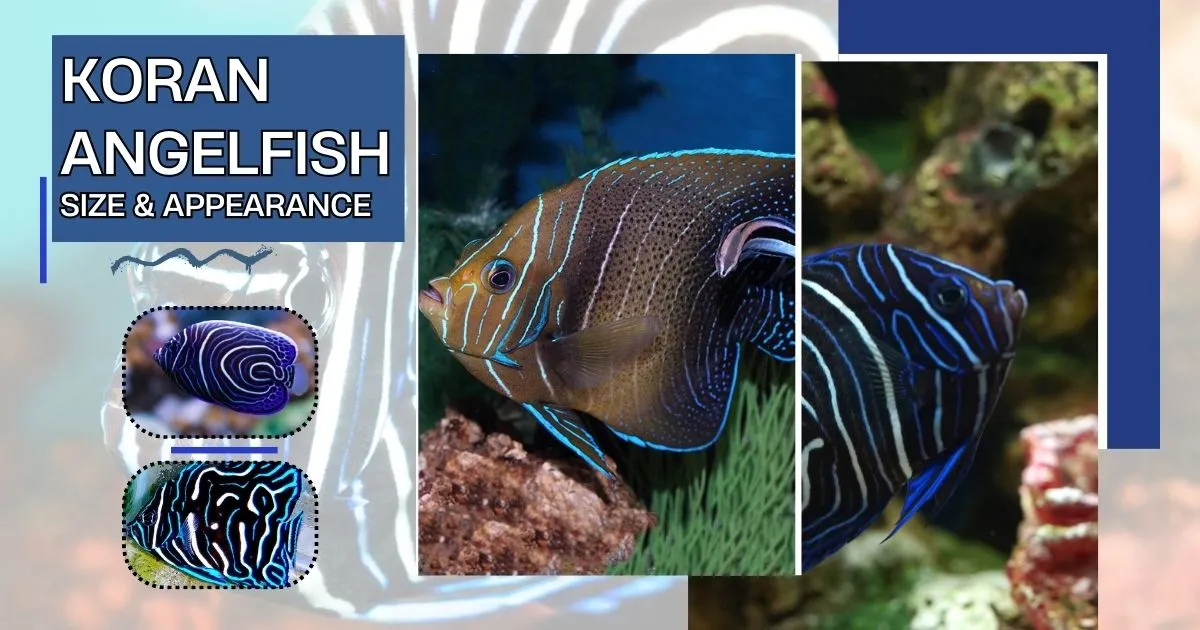
The adult koran angelfish has a brownish anterior and posterior third of the body, with a greenish or yellowish center. The sides are covered in spots, and the filaments on the dorsal and anal fins are bright yellow. The head is yellowish-green, with sapphire-blue gill margins and eye rings. The koran angelfish changing colors are simply marvelous.
Fun Fact: The biggest scientifically measured Koran angelfish was 40.0 cm / 15.7 in.
The source of the common names Semicircle Angelfish, Half-circle Angelfish, and Half-circled Angelfish becomes clear when you look at specimens with a length of roughly 1-3 inches.
The fish’s body is covered in asymmetrical back semicircles at this stage. The semicircles will become sweeping lines as the fish becomes larger. When the fish is roughly 4-7 in, It will show a blue pattern similar to Arabic script on the tail fin, which is why one of the common names for this species is Koran Angelfish. The pattern consists of blue markings against black between blue lines.
Koran Angelfish Growth Rate
These fish grow at a slower and more consistent rate than small freshwater fish. Furthermore, their growth rate tends to slow as they mature.
Patience is essential while rearing marine angelfish, as they might take years to be adult koran angelfish.
Read Also: How Fast do Koran Angelfish Grow?
Regularly monitoring the fish’s health, observing behavior, and providing a proper environment all contribute to optimal growth. Koran Angelfish, like any other aquarium species, requires a well-maintained and stable habitat to thrive and grow in any fish tank.
Adult Koran Angelfish
Adult Koran Angelfish can grow quite large, and their size is influenced by factors such as tank size, nutrition, and climatic conditions. The adult coloration is a blend of blue, yellow, and orange hues. Their distinguishing patterns and markings become more intricate and beautiful.
Pro Tip: It is often recommended to quarantine new fish for a few days before adding them to the main tank so that if these have any kind of disease, it would not affect the other species of the tank.
Setting Up Tank for Koran Angelfish
Creating the right tank conditions is of utmost importance for the well-being and healthy life of your Koran Angelfish. Here are some key factors to consider while you are setting up a tank for this species.
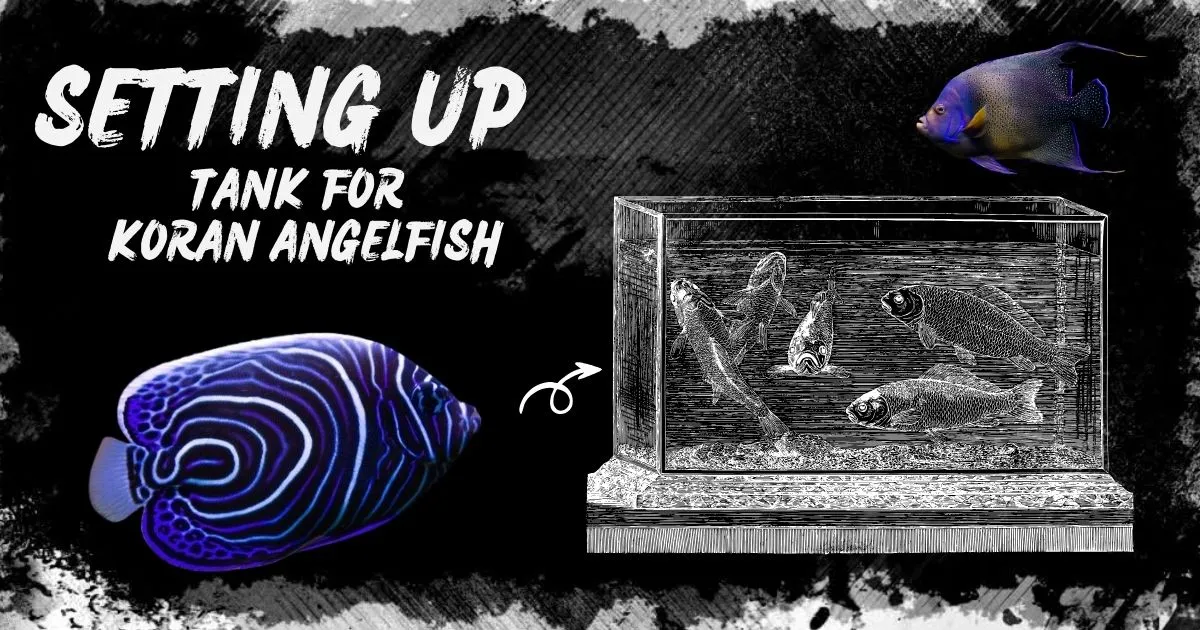
Koran Angelfish Tank Size
Due to their large size and active swimming habits, Koran angelfish requires spacious tanks with plenty of unobstructed swimming rooms. Since Koran Angelfish are large, energetic fish, it is advised that a single fish must not have a tank less than 125 gallons in size. Larger tanks are better if you intend to keep numerous angelfish or other tank mates. A community tank of size of at least 180 gallons is recommended to accommodate them. So the Koran angelfish tank size may range from 125 gallons minimum.
Water Conditions
To replicate the natural habitat of Koran Angelfish, it is important to maintain certain water conditions in your aquarium. The recommended water parameters for Koran Angelfish are as follows:
- Temperature: 72°F – 80°F (22°C – 27°C)
- pH: 8.1 – 8.4
- Specific Gravity: 1.020 – 1.025
- dKH: 8 – 12°
- Ammonia: 0ppm
- Nitrite: < 0.2ppm
- Nitrate: < 10ppm
Water Filtration for Blue Koran Angelfish
Regular water testing and maintenance will play a vital role in ensuring a healthy and stable environment for your Koran Angelfish. Make use of a top-notch filtration system to maintain clear, pure water. Protein skimmers can assist in keeping water clean by eliminating organic waste.
Koran angelfish likes a moderate water flow because it mimics the currents in their natural environment. Wavemakers or powerheads can assist in achieving this.
Lightening
Since Koran Angelfish frequently reside in habitats with lots of coral, make sure there is enough lighting to promote the growth of living corals. To simulate sunlight, use LED lights that can be adjusted in terms of both spectrum and intensity.
Décor & Aquascapes
To make the Koran Angelfish feel safe and secure, provide them with many caves and hiding places. They value living rock formations and rock structures that mimic their native reef environment.
To replicate the sandy ocean floor, use a fine substrate, which enables the fish to display their innate digging habit. Including plenty of rocks and overhangs in the tank can act as hiding spaces for the Koran Angelfish. You can also carpet your tank bottom with Java Moss. These hiding places serve as retreats when they feel frightened or tired, ultimately reducing stress levels and promoting healthier lives.
Acclimating Saltwater Koran Angelfish
When introducing Koran Angelfish to your aquarium, it is important to follow proper acclimation procedures to ensure their smooth transition. Koran Angelfish are considered hardy and adapt well to aquarium life, particularly when introduced as sub-adults measuring around 3-5 inches.
Pro Tip: I recommend you to cycle your tank thoroughly before adding a new fish to your Aquarium.
It is essential to avoid adding Koran Angelfish that is too small or too large to the tank. Juveniles measuring 2 inches or less may have difficulty adapting, while adult koran angelfish and older individuals may struggle to feed in their new surroundings. Aim for an ideal size range of 3-5 inches when adding Koran Angelfish to your tank. You can find these at your local fish store for about 40-$100.
Additionally, be cautious when placing the Koran Angelfish with other fish, as they can be territorial and show aggression towards species of similar size. It is recommended to keep them in a large tank of at least 180 gallons, where they can coexist peacefully with a male or female combination of distinctively different patterns and colors.
Koran Angelfish Food (Feeding Your Fish)
These fish are known to be omnivorous and should be fed a varied diet to support their nutritional needs. While they can consume various protein sources like shrimp, clams, shellfish, and squid, it is vital to ensure their diet leans towards algae and plant-based food for optimal health.
Feeding them algae, seaweed, spirulina, and Nori will provide essential nutrients. These can be supplemented with meaty proteins to create a balanced diet. A recommended diet plan for Koran Angelfish includes nori, spirulina, mysis shrimp, and brine shrimp offered 2-3 times per day.
These fish are natural algae-eaters and will also consume any available algae in the tank. If there is a lack of algae, supplementing their diet with nori sheets is recommended.
However, in a reef tank, it is necessary to monitor their feeding habits closely, as they have been known to eat sponges and pick at coral. Regular feeding and observation will help prevent any damage to the reef ecosystem.
Regular feeding and providing a balanced diet will promote the health and vitality of your Koran Angelfish
Koran Angelfish Tankmates

For the Koran Angelfish selecting compatible tankmates is very necessary to create a calm and serene aquarium atmosphere. Despite its tendency towards territoriality, particularly towards other angelfish, Koran Angelfish may get along with a variety of suitable species. The following fish could be placed in Koran Angelfish’s tank.
Also Read: Angelfish Tank Mates: A Comprehensive Guide for Compatibility
Butterflyfish
If there is adequate room and hiding places, several butterflyfish species, like as the Raccoon Butterflyfish (Chaetodon Lunula) and Copperband Butterflyfish (Chelmon Rostratus), can live with Koran Angelfish.
Large Clownfish
Larger clownfish species, like Amphiprion Clarki, or Clark’s Clownfish, can coexist. Make sure the tank has adequate room for both species to live in comfort.
Damselfish
Certain larger damselfish species can make good tankmates, such as Dascyllus Trimaculatus, the Domino Damsel. But keep an eye on their actions because damselfish people can be possessive.
Gobies
Koran angelfish get along nicely with calm goby species like the Yellow Watchman Goby (Cryptocentrus Cinctus). The tendency of gobies to remain near the bottom of the tank reduces the likelihood of territorial disputes.
Rabbitfish
Certain species of Rabbitfish, like the Foxface Rabbitfish (Siganus Vulpinus), are peaceful and can share the same tank with Koran Angelfish.
Wrasse Species
Numerous wrasse species make good tankmates since they frequently coexist peacefully and occupy distinct regions of the aquarium. The Fairy Wrasse (Cirrhilabrus sp.) and the Six-Line Wrasse (Pseudocheilinus Hexataenia) are two examples.
Tangs and Surgeonfish
Because they have diverse eating habits and are generally more energetic, tangs like Purple Tangs (Zebrasoma xanthurum) and Yellow Tangs (Zebrasoma flavescens) get along well with one another.
Note: “Koran Angelfish are generally peaceful but sometimes they may exhibit territorial behavior so providing sufficient hiding spots and carefully selecting tankmates is necessary for a pleasant aquarium environment.”
Common Diseases
Like any other aquarium fish, Koran Angelfish is prone to some diseases if suitable husbandry procedures are not followed. The following are a few dominant diseases that Koran Angelfish in aquariums may contract:
Marine Ich (Cryptocaryon Irritans)
Marine Ich is a common protozoan parasite that can infect the skin, gills, and fins of fish. Symptoms include white cysts resembling grains of salt on the fish’s body, rapid gill movement, and lethargy.
Parasitic Flatworms (Neobenedenia spp.)
In marine fish, these flatworms can infect the skin and gills. Rapid gill movement, scratching against things, and obvious flatworms on the skin are some of the symptoms.
Stress-Related Issues
Koran Angelfish are more prone to illness when their immune systems are weakened by stress. Stress-related issues can be exacerbated by things like poor acclimatization, abrupt changes in water conditions, or hostile tankmates.
Fungal Infections
Injuries and damaged fins are common sites for fungal infections. On the lips, fins, or skin, a white, cotton-like growth is frequently indicative of a fungal infection.
Preventive Measures and Treatment:
- Always quarantine new fish before adding it to the main tank to prevent the spread of diseases.
- Keep steady water parameters, such as pH, salinity, temperature, and nutrient levels, under regular observation.
- A healthy, diverse diet strengthens the Koran Angelfish’s immune system.
- Pay close attention to the behavior, appearance, and eating habits of your fish. Early detection of issues allows for prompt treatment.
- If a disease is identified, move the affected fish to a quarantine tank for treatment to avoid spreading the infection to other tankmates.
Regular water testing using a reliable kit is important to monitor parameters such as ammonia, nitrate, nitrite, specific gravity, temperature, dKH, and pH. Maintaining these parameters within the recommended range will help prevent health issues and promote the well-being of your Koran Angelfish.
Behaviour and Compatibility of Koran Angelfish
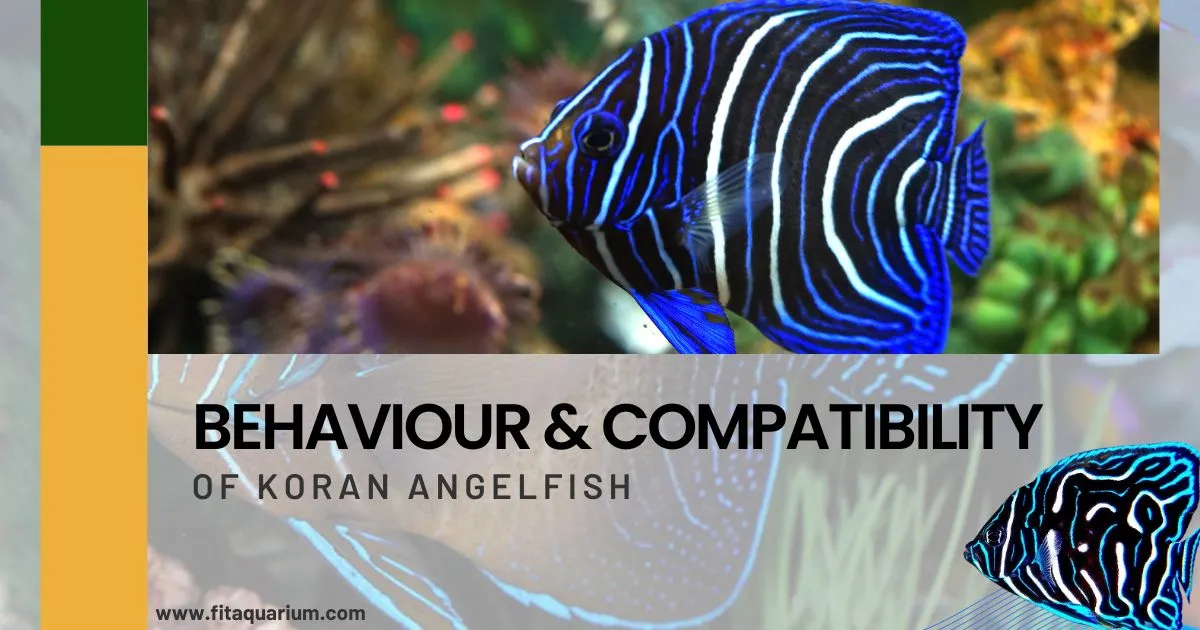
Understanding the behavior and compatibility of Koran Angelfish is essential for maintaining a harmonious aquarium environment. Here are some key aspects to consider:
Reef Compatibility
Unfortunately, Koran Angelfish are not considered reef-safe due to their tendency to pick at and consume various sessile invertebrates, including corals, sponges, and anemones. If you have a reef tank, it is best to avoid keeping Koran Angelfish to preserve the integrity of your coral ecosystem.
Breeding
While there haven’t been significant reports of successful breeding of Koran Angelfish in a home setup, some instances of successful breeding by institutions such as the University of Florida’s Tropical Aquaculture Lab have occurred. Captive-bred Koran Angelfish have been raised from fry into juveniles, offering promising opportunities for further study and conservation efforts.
Also Read: How to Breed Neon Tetras (Simple Steps to Follow)
Where to Purchase Koran Angelfish
I am sure that now you want to add Koran Angelfish to your aquarium. You must buy this species from a reputable source.
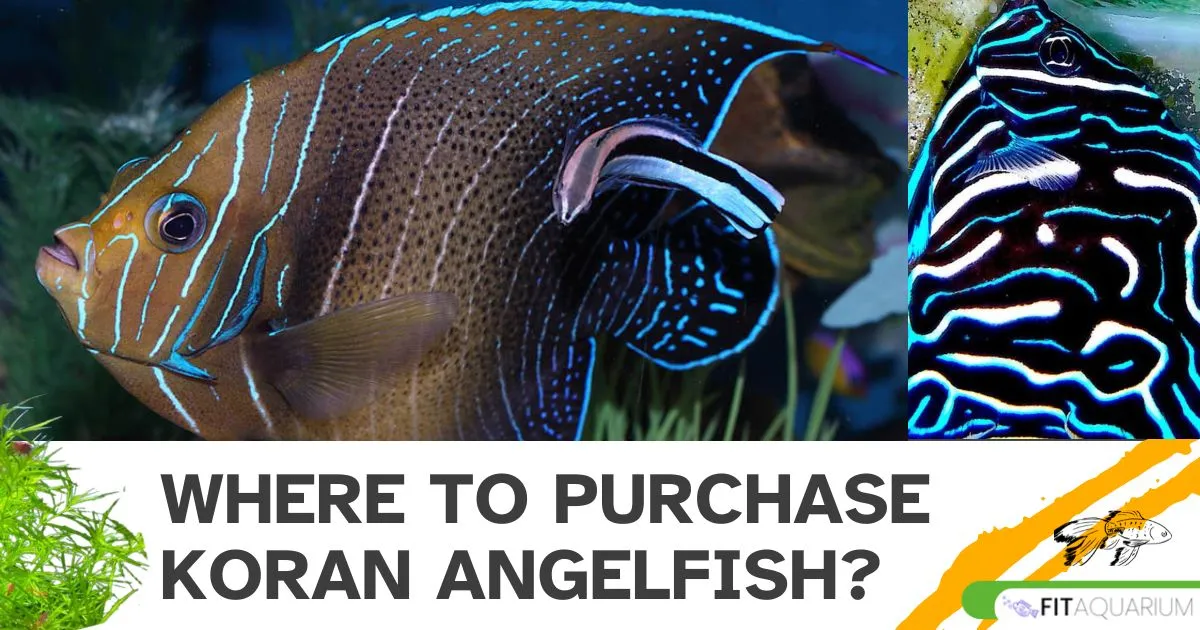
From my personal experience, when it comes to acquiring aquatic companions, opting for local pet stores is a wise choice. Not only does it support nearby businesses, but it also ensures a healthier and more ethically sourced addition to your aquarium. Here’s why:
- Physically examining the fish allows you to assess their health firsthand, reducing the risk of introducing diseases to your existing aquatic community.
- Purchasing from local businesses fosters a sense of community, and fostering relationships with experienced aquarists in your area.
Conclusion
Conclusively, Koran Angelfish can be a breathtaking addition to your saltwater aquarium. By following the care recommendations outlined in this guide, you can provide a suitable environment for these magnificent creatures.
By following these guidelines, you may create a joyful and beautiful underwater environment for your Koran Angelfish to thrive in. With careful consideration of water quality, sufficient feeding, and a dedicated approach to tank management, you will enjoy the grace and beauty of the Koran Angelfish, cultivating a harmonious and colorful underwater world within the boundaries of your aquarium.
Here is short video to help you have a view on this beautiful species.
Enjoy your experience as a fishing enthusiast!
Also Read: Regal Angelfish Care 101: [A Comprehensive Guide]
Frequently Asked Questions
Here are some Frequently Asked Questions about Koran Angelfish
What size tank does a Koran Angelfish need?
An aquarium of at least 120 gallons (480 liters) is recommended for a single Koran Angelfish.
How long do Koran Angelfish live?
The Koran Angelfish can live up to 21 years in A tank so you’ll be able to enjoy watching them swim around your tank for a long time.
How often should I feed Koran Angelfish, and what are their dietary requirements?
Koran Angelfish should be fed multiple small meals throughout the day, at least three times. Their diet should be rich in algae-based foods such as nori, spirulina, and marine algae. They can also be supplemented with meaty proteins like shrimp, clams, shellfish, and squid. It is important to monitor their feeding habits closely in a reef tank to prevent any damage to corals or sponges.


